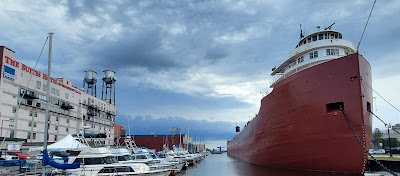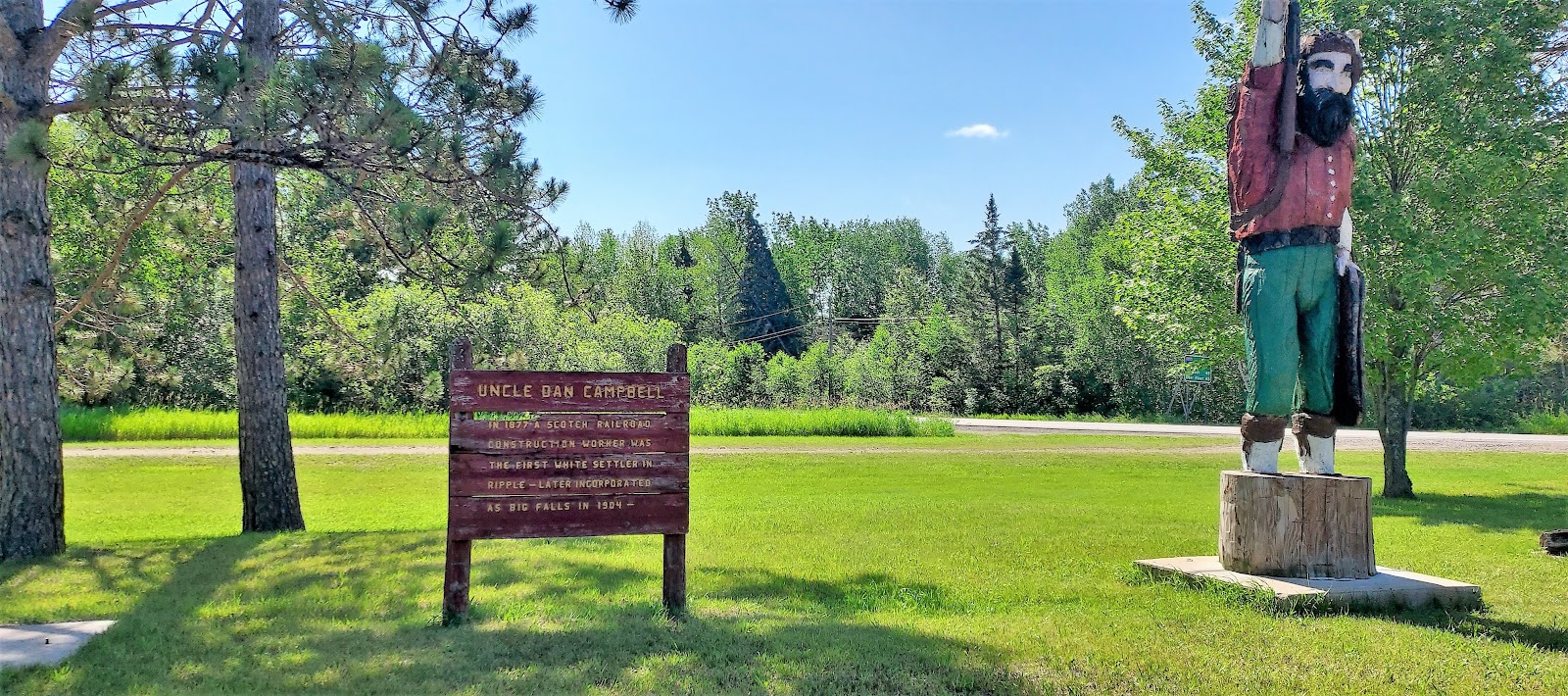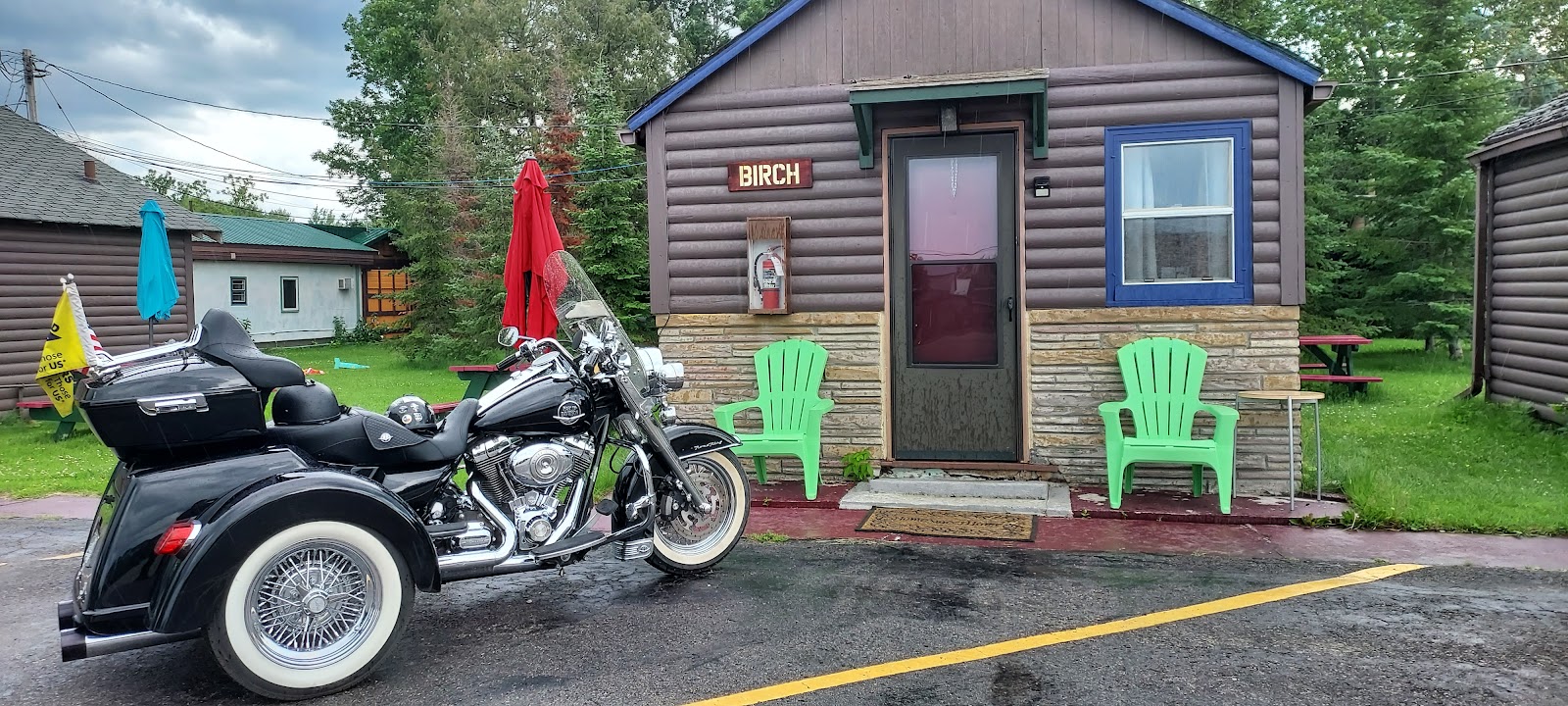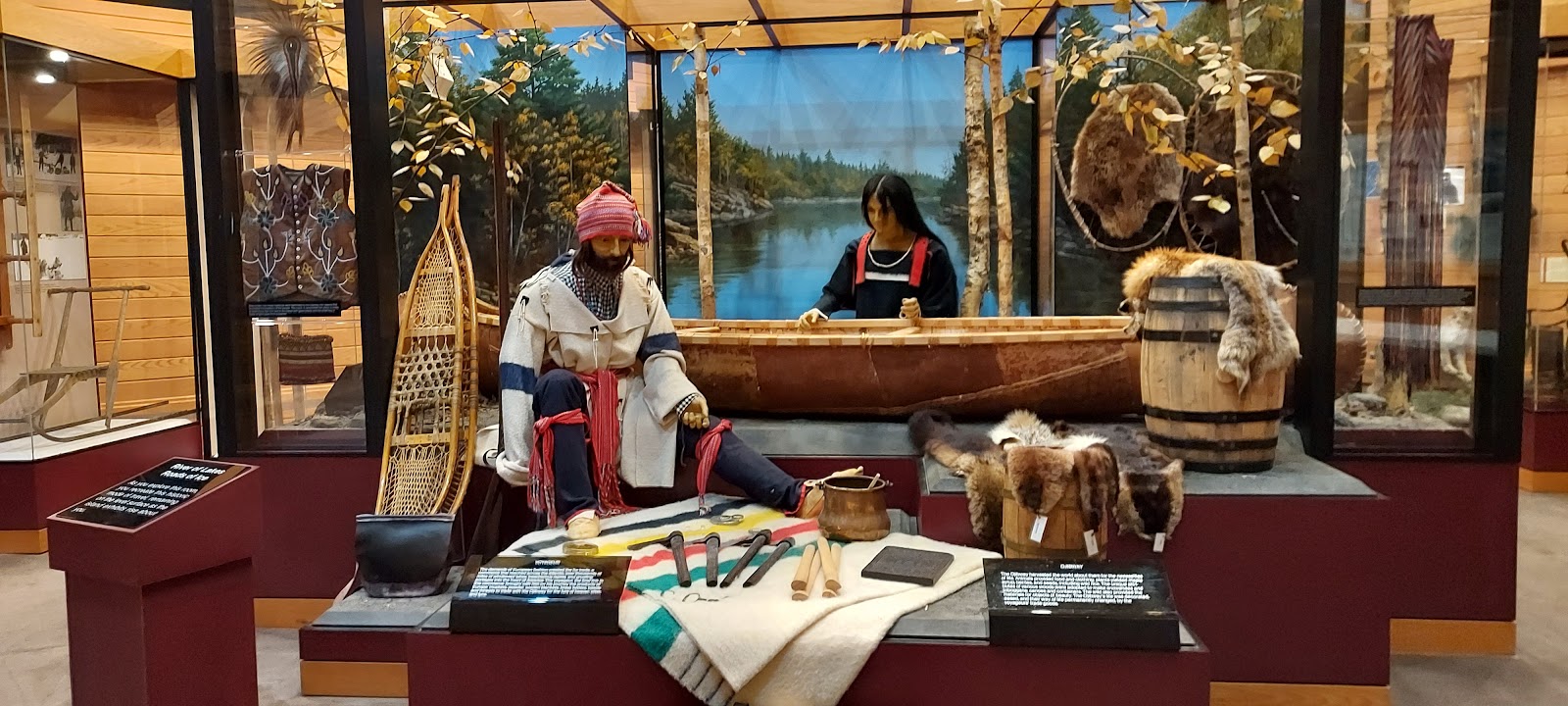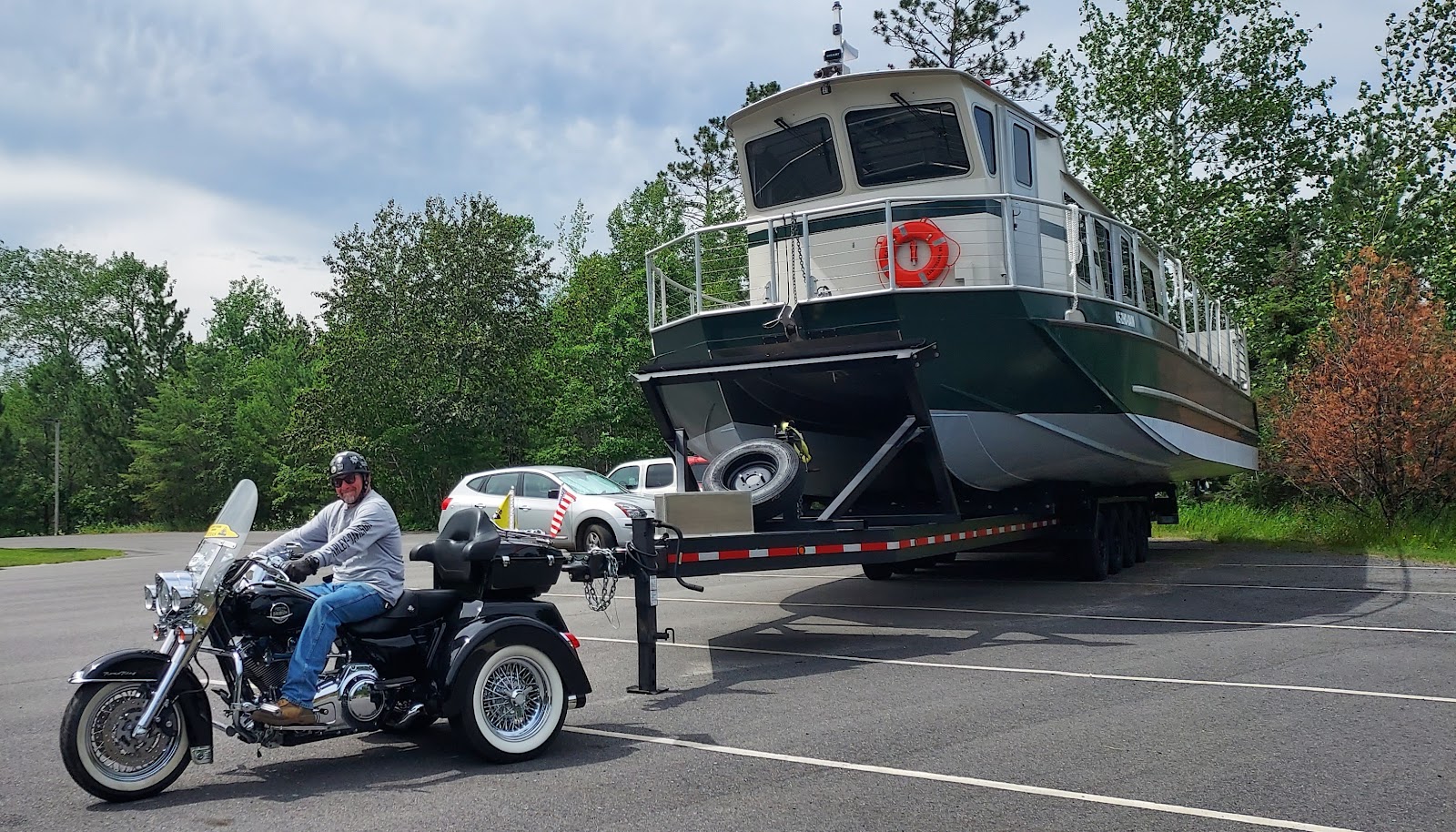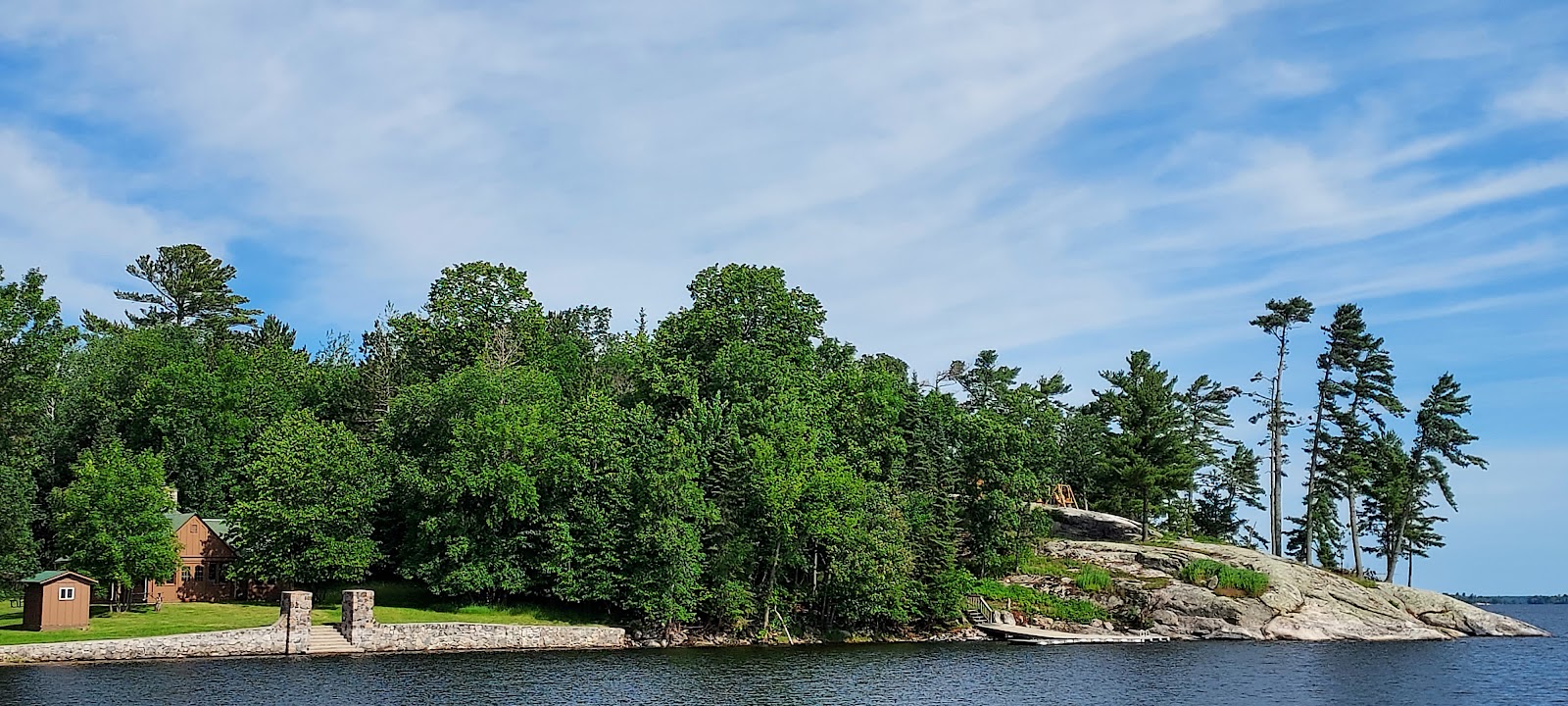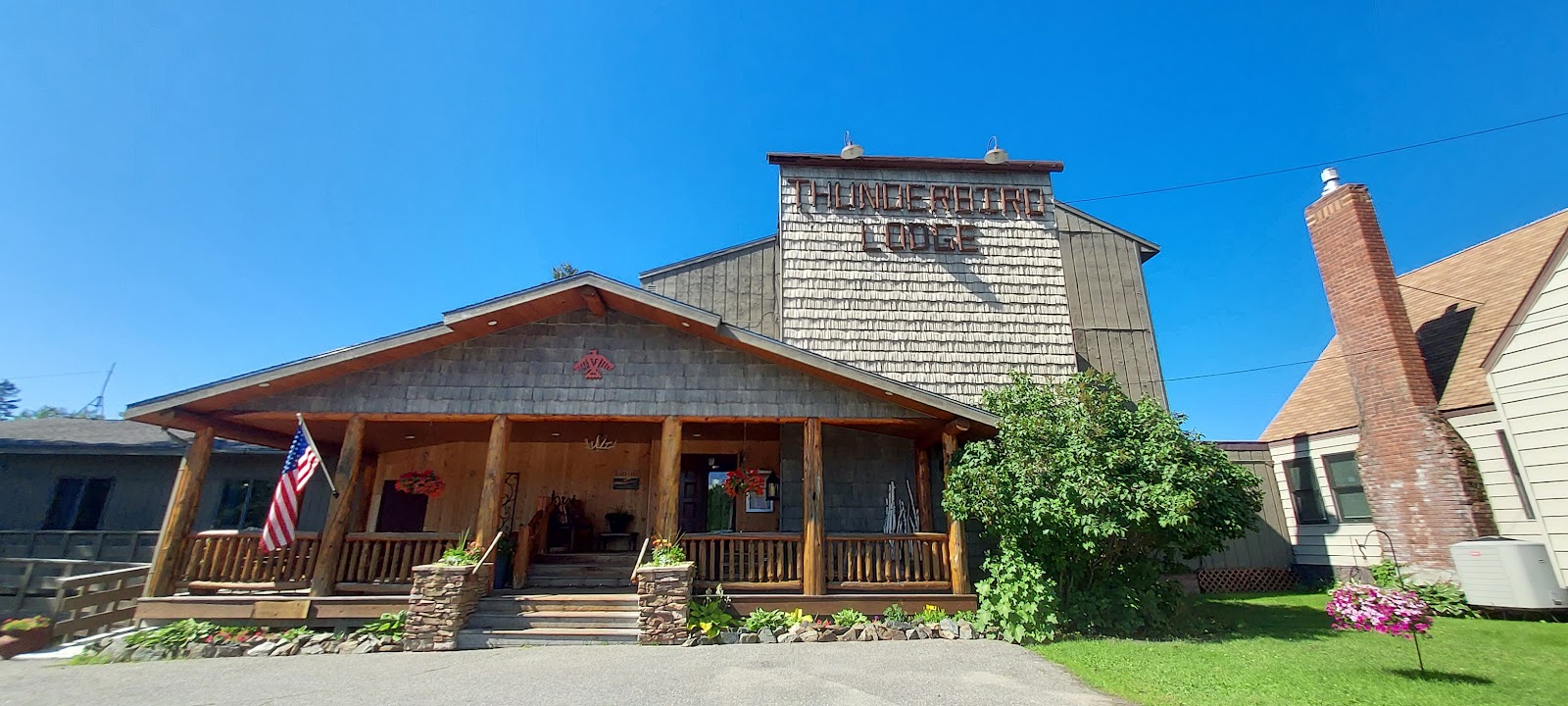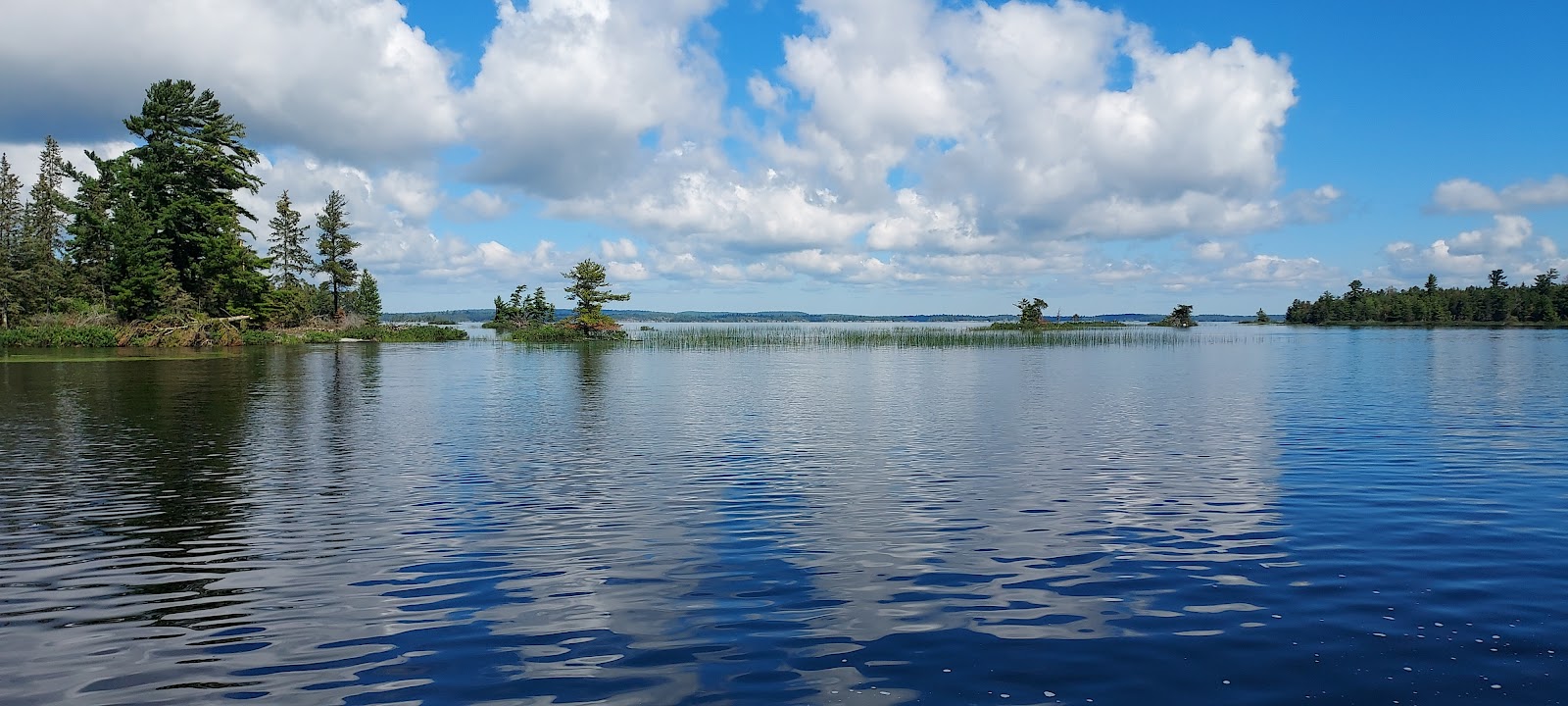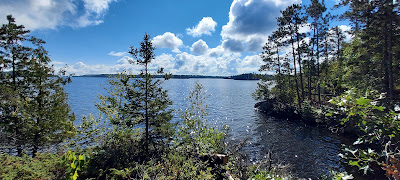We had so much to see and do on our days off from volunteering at Edge of the Wilderness Discovery Center in Marcell, Minnesota.
Visiting Itasca State Park was a top priority. It is Minnesota’s oldest State Park, established in 1891. That same year, after much discussion and disagreement throughout the ages, it was declared officially that the headwaters of the Mississippi River are formed at Lake Itasca within the Park borders. So, we just had to visit the humble beginnings of the Mighty Miss. The River goes North a short distance, then curves Easterly before flowing South to its destination: the Gulf of Mexico. It is said that a raindrop takes 90 days from the time it falls to reach the Gulf. I’d love to follow that raindrop on its journey! We perused the outdoor exhibits at the Mary Gibbs Mississippi Headwaters Center, then hiked along the less populated Sawmill and Schoolcraft Trails, the latter of which was adorned with lovely lady slipper blooms. We walked solemnly through the ancient Indian burial mounds, respectful of these sacred lands. We enjoyed an early lunch at the Headwaters Café to refortify for the rest of our exploration.
 |
The "official" headwaters of the Mighty Mississippi. |
 |
| The lady slipper blooms. |
 |
| Wegmanns' recreated cabin, compliments of the CCC. |
 |
| Wegmann gravesite in the Pioneer Cemetery |
 |
| Preacher's Grove |
 |
| Warm and welcoming Visitor Center. |
Our visit to Scenic State Park wasn’t quite as scenic as we had hoped—there are several road construction and campsite improvement projects in the works. But we came specifically to hike on the eskers on Chase Point Trail. What’s an esker, you ask? I didn’t know either, so I’ll share what I learned. An esker is a long, narrow, winding ridge of sand and sediment deposited by a stream that ran beneath a glacier many moons ago. Cooler temperatures and a brisk breeze made it feel like early Autumn—my kind of weather for a day in nature.
 |
| The trail along the esker. |
 |
| The hike took us to a viewpoint of Coon Lake. |
We took a daytrip to the Boundary Waters area. It was a LONG ride on Maximus the Trike—we incurred construction delays on each and every road we traversed. Northern Minnesota is very much like Alaska. It has only 2 seasons: Winter and road construction. We were disappointed that we could not take the US Postal Service boat at Lake Vermilion, wherein you join the postman as he travels by vessel to deliver mail to areas along the Lake that are not accessible by road. It’s a 3-hour daily ride covering 65 miles. But what was once a well-kept secret has received national media attention, so we learned that the boat now books up swiftly. Instead, we visited the International Wolf Center, which prides itself on being a leading source on wolf behavior. Not calling this place a "zoo" is semantics to me. Like the Lakota Wolf Preserve we visited many moons ago in New Jersey, the International Wolf Center claims it does not breed, train, or influence the behavior of the pack that live on premises. They simply research, monitor, and record. But conditioning the wolves with “enhancement techniques” pretty much turns them into Pavlov’s dogs in my view. I did, however, enjoy watching the film immensely. It focused on the Ojibwe tale of Anishinaabe the human and Ma’iingan the wolf and their close relationship. As the tale goes, the Creator made the human Anishinaabe. But Anishinaabe was lonely and asked for a companion. The Creator gave him the wolf Ma’iingan, and the two became as close as brothers, going everywhere together. But the Creator warned that at some point in time, the two would need to part ways. It was said that though separated, whatever happened to one of them, would happen to the other. Hence, both the Ojibwe Anishinaabe and the wolf Ma’iingan suffered a loss of land and a loss of identity, almost to the point of extinction. But as time went on, both survived, strived, and thrived. An interesting and inspiring tale.
My parents made the mistake of leaving me home one evening when they went a few miles down the road to Hayslip’s Corner, Minnesota’s oldest bar. Well, with them away, you know the rodentia will play. So, my pocket pal, Nezumi, and I threw a pop-up party. Everyone had a fabulous time. But I had 1 poop head, Marvin the Mouse, who just overstayed his welcome. He turned into a squatter. So, I am in HUGE trouble with Mom, who has no love of rodentia in our home other than stuffed toy versions like me and Nezumi. And, of course, Dad has turned into Elmer Fudd trying to evict Marvin. Trust me, it won’t end well for Marvin. And I suspect that I won’t be left home unsupervised again for a while.
We had another 4-day mini getaway, this time to Duluth and Lake Superior’s North Shore. We traversed along MN-2 East, stopping to view the Duluth Missabe and Iron Range Engine 225. Commissioned in 1941, it hauled 44 million tons of ore from the Mesabi and Vermilion Ranges and traveled nearly 700,000 miles during its 20 years of service.
Soon we arrived on the shores of Lake Superior. While early August should be the “dog days of summer”, the thermometer was not indicative of it. It registered a comfortable 74F degrees, but it felt considerably cooler with the crisp air blowing off the Lake. Our first stop was to tour the S.S. William A. Irvin, one of the first class of Great Lakes iron ore vessels (A.K.A. “Lakers”) with electric steering. Built by U.S. Steel in 1938 at a length of 610 feet, she was retired in 1978 because she was considered too small compared to newer vessels like the Edmund Fitzgerald, which registered over 725 feet. (Of course, the S.S. Irvin fared much better than the ill-fated Edmund Fitzgerald, which sunk in Lake Superior in 1975).
 |
| Area for VIP guests. |
 | ||
This display is in the hull of the ship!
|
We were traversing through Canal Park and along the Lakeway Trail in search of an eatery when we stumbled upon Va Bene. Who would have thought we would find good Italian food in Minnesota? We were willing to give it a try since it had options for Dad and some lovely views of the Lake. And we were pleasantly surprised. We all had tasty pasta primavera with San Marzano tomatoes. Mom awarded Va Bene extra points because they served bread with the meal. Though it wasn’t a Brooklyn-baked Italian loaf, it was homemade, delicious, and much appreciated. Fortified with full bellies, we walked over to Duluth Trading Company. Though this visit was a BIG DEAL for Dad, he said he could live without the $22 no pinch, no sweat, no stink boxer shorts. Instead, he and Mom spent over $200 on matching raingear. Though it looks like it will be of good use with the weather forecasted here, I think they just should have adopted my thrifty raingear choice—a 3-millimeter trash bag.
 |
| Some views from Lakeview Trail and Canal Park... |
As we walked along the streets of Duluth, I loved the way the City repurposed outdated buildings. Warehouses were converted to retail spaces, and a telephone substation smaller than a tiny house is now an ice cream shop. Even chain restaurants like Red Lobster that usually have a distinct exterior style/floorplan are housed in converted buildings.
We checked into the Historic Willard Munger Inn. Willard Munger holds the distinction of being
Minnesota’s longest serving representative.
He served for a total of 42 years, 7 months, before dying in 1999. At 88 years old, he was also Minnesota’s
oldest legislator. He established the
Inn in 1954, and it is now run by his grandson.
The “inn” is more like an old-school motor lodge, though management has
been working diligently to enhance the amenities. For $100/night, it offered everything we
needed since we were only in it for sleeping, and it had some pretty
grounds/outdoor seating areas. Obviously, others felt the same way since the place was booked solid. Furthermore, a nice
biking/hiking trail runs right behind the property. The trail is named in honor of Munger, an
avid environmentalist.
We boarded Maximus the Trike early the next morning and
traveled along North Shore Drive. We
stopped at several scenic lookouts along the way, though tree growth now
blocks what once was a pristine view. We
passed through Beaver Bay, population 120, which was once part of the trade
route. I wonder if any beavers still
reside there?
 |
 |
| Silver Creek Cliffs and Tunnel as viewed from the Gitchi-Gami State Trail. |
 |
| Rocky, the mascot of Silver Bay and its taconite mining industry. |
We passed a couple of cute residential properties. Then we did a double take—holy horse poop! What the heck? At first it looked like a pile of rubbish, remnants of a fire or even an old garage sale. But the more closely we examined, we realized it was a piece of art. Utilizing animal statues, mirrors, and an assortment of natural and manmade materials, it was a unique recreation of wildlife residing in natural habitat.
 |
| Beauty is in the eye of the beholder. Once I figured out this artistic creation, I was intrigued. It was like finding hidden images in Highlights Magazine! |
We reached our late-morning destination: Naniboujou Lodge and Restaurant. We were super excited to come here, having heard wonderful things about it. And they all proved true! It is a gorgeous property along the shores of Lake Superior. Built in the 1920s by high-profile investors like sports figures Babe Ruth and Jack Demsey, it was a wealthy man’s getaway. Today it is a welcome retreat from electronics--no cell service, no TVs, no Wi-Fi, just the peace and serenity of nature. The dining area is spectacular! Painted in vibrant, Southwestern motifs, a hand-masonry stone hearth stands front and center. We planned to eat lunch here, but we learned quickly that this was not to be. The restaurant, like so many other businesses, was suffering a staffing shortage. Therefore, only breakfast and dinner service was offered now. Meals were all buffet style, no open menu offerings. The real kicker, though: the restaurant was only accommodating its lodging guests—it was no longer available to the general public. I was totally bummed. My parents appeased me by letting me take a dip in the cold waters of Lake Superior, the 4th of the Great Lakes we have visited.
 |
| Me and Dad along the shores of Lake Superior. |
We returned to Grand Marais to seek an alternate eatery. We settled on The Gun Flint Saloon, which had several options for Dad. I won’t bore you with all the issues that transpired (including, but not limited to, having 2 tables that were seated AFTER us receive their entrees and be halfway through their meals before Dad even got his soup appetizer.) Let’s just say that the food was tasty, but the service was ABYSMAL!
 |
| A lovely rose garden in Grand Marais. |
After lunch, we went to Split Rock State Park to view the Lighthouse. We learned the Lighthouse is operated by the Minnesota Historical Society and is a separate entity from the State Park. So, we were not required to pay the State Park fee, only the $12/adult entrance fee for the Lighthouse. Prior to US-61 opening to tourism in 1924, this area was only accessible via boat. Every year, boats would continue to make journeys later and later into the fall season. Pushing the envelope proved disastrous on November 27, 1905. A 12-hour storm from the South Dakota Plains came through, causing 33 fatalities and damaging 38 vessels at Split Rock Point. In 1910, the government completed building this taxpayer-funded lighthouse. Building supplies were shipped and hoisted up the cliff through a tramway system, of which we saw remnants when we hiked the Boardwalk Trail. The Lighthouse was decommissioned in 1969 after being under the diligent care of 38 keepers and their families over its 59 years of service.
 |
| Looking up the stairs inside the lighthouse. |
 |
| We traversed up and down the Boardwalk Trail, which ran parallel to the once-used tramway. |
 |
| Lightkeepers' housing from back in the day. |
The next itinerary item was hiking in Gooseberry Falls State Park. The Falls here are multi-tiered and quite lovely. Decades ago, A Civilian Conservation Corps (CCC) Camp existed on the grounds behind Upper Gooseberry Falls. It’s hard to imagine with all the tree growth now.
 |
| Upper Gooseberry Falls |
 |
| Lower Gooseberry Falls |
Lastly, we visited Tettegouche State Park to hike to the Baptism River Falls, the tallest water falls entirely within Minnesota.
As we hiked, I was fascinated watching this centipede take down a worm! Look for yourself!
With the cold air coming off Lake Superior and the sprinkling of rain, I froze my buns off on the ride back to the motel after sundown. (This is where my trash bag cannot compare to my parents' new Duluth Trading Company raingear). But my discomfort was a small price to pay for the fun-filled,
productive day of touring I enjoyed.
We scheduled our trip to the North Shore to coincide with the biennial 4-day Festival of Sails. This is when the historic tall ships come to the Lake Superior harbor. Typically, the Festival is held within Duluth, which has all the infrastructure (parking, eateries, lodging, etc.) needed to pull off an event that attracts more than 100,000 visitors. However, due to waterfront construction in Duluth, the 2022 event was held in Two Harbors. Consisting of only 3.28 square miles and a mere 3,600 residents, hosting the Festival proved to be too ambitious an undertaking for tiny Two Harbors. It was the proverbial “who’s on first?” cluster of confusion. They had tons of volunteers, but most were embarrassed and frustrated by the disorganization and lack of basic information/direction they received.
The chaos started with the directional signage for the
various off-site parking lots from which guests were required to take shuttles. We would turn following the arrow on a sign on the main road, then would never find another sign. It turns out the powers-that-be had not
finished putting up all the signs. This
was at 7:30 a.m., and the first shuttles were due to leave parking lots at 8
a.m. Nothing like waiting until the last
minute. At least we weren’t the only
folks confused. We kept meeting up with
another couple that was searching for the same parking lot we were.
We finally found the parking area and boarded the shuttle. But the shuttle driver didn’t know where to discharge his passengers. He dropped us off and told
everyone to go into a building to show our tickets. Inside, the volunteers said we need to walk
about 1/4 mile down the road. We walked over to the specified area and were told that the area is only for vendors. We were instructed to walk back almost to
where we started. Yeesh!
Though we did not opt for the ticket to board the ships, we did pay to get on the dock to watch the vessels sail. Yet, several volunteers denied us entry. We finally found one gentleman who granted us access, acknowledging that we should get what we paid for. It was fun watching the tall ships leave the harbor, though most did not use their sails. We stayed on the dock awaiting the return of the ships, only to learn that 2 of the 4 vessels were not coming back into the harbor at all. They had paying customers on board and were taking them on a tour.
My favorite example of confusion, however, was a woman who
claimed to “be in charge”. She provided the
response, “that’s a really good question” to a man who asked what time the
shuttles would begin on subsequent days of the Festival. But she never answered his query. Instead,
she just turned and walked away, never to return. Who’s on first? Not only was no one on first, these
volunteers weren’t even in a ballpark!
We did have one unexpected highlight: we watched a 1,000-foot Laker dock. That Captain parked that sucker quicker than
Mom can park Big Boomer, our medium duty truck!
Before departing Duluth, we drove over the Lake Avenue Bridge, which was just about to rise slightly to let a small boat through. We stopped at the Minnesota Point Public Beach to dip our feet into Lake Superior. With a surface area of 31,700 square miles, the Lake is comprised of 3 QUADTRILLION gallons of water. The water temp registered a chilly 56F degrees, not as frigid as the Polar Bear Plunges at NJ beaches each January (typically mid-40F degrees), but cold for early August. I was amazed at how the Lake created waves just like an ocean! In fact, one local told us he has witnessed waves 35 feet in height!
We returned to Maximus the Trike and crossed over the state line, arriving at Wisconsin Point in Superior, Wisconsin. The St. Louis River feeds Lake Superior in this area. We parked by the lighthouse. It is privately owned by a tech billionaire. He apparently knows not what to do with his money, since the lighthouse remains abandoned. We stopped at the Chippewa burial grounds. Some of the bodies interred here initially were exhumed and moved. However, based on artifacts left in the area, members of the Chippewa tribe still consider the area sacred. So, out of respect, we refrained from taking photos. Before we hit the road for our return to Marcell, we enjoyed an excellent veggie pizza at Toppers, a veteran-owned business in Superior. How ironic to find a pizzeria within the proclaimed Cheese State that offers non-dairy cheese alternatives!
 |
| The break wall across from the lighthouse is Minnesota Point, the beach area that we visited just an hour earlier. |
 |
| Out of respect, we did not take photos within the burial grounds. |
 |
| Lovely house museum, which unfortunately was not open to take a tour. |
Well, that concludes my final blogpost on our summer in Minnesota. Our volunteer commitment at the Edge of the Wilderness Discovery Center had come to an end. Though we weren’t fortunate enough to witness the Aurora Borealis, we loved volunteering in and touring the Great North State. I may never have seen a beaver here that wasn’t stuffed by a taxidermist or viewed a porcupine that wasn’t roadkill, but I was privy to many wonderful wildlife sightings. This truly has been a Rambling RV Rat 5-cheese experience.
Tomorrow we hit the road to tour the San Luis Valley of Colorado.



